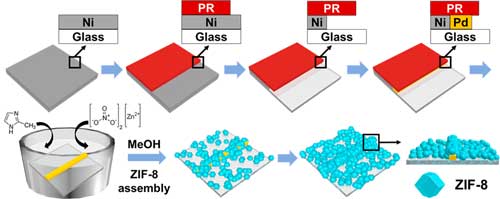| Posted: Sep 04, 2017 | |
Engineered nanofilter accelerates hydrogen sensor(Nanowerk News) Among the various types of hydrogen gas sensors, palladium-based resistor-type hydrogen sensors have been widely studied because of their simplicity, low cost, and adequate sensitivity, but the response and recovery speed of these H2 sensors – even those based upon nanoscale palladium sensing elements – has been insufficient. |
|
| In a new paper in ACS Nano ("Accelerating Palladium Nanowire H2 Sensors Using Engineered Nanofiltration"), researchers describe an efficient architecture for H2 sensors in which a nanofilter is interposed between the sensing element – an array of palladium nanowires – and the gaseous ambient. | |
| The nanofilter, which is highly permeable to H2 but impermeable to other large gases, is a zinc-based zeolite metal organic framework (ZIF-8) layer that is synthesized directly on top of the palladium nanowires from methanolic solution. | |
 |
|
| (a) Schematic illustration of synthesis of Pd NWs@ZIF-8 using LPNE process and following assembly process. (© ACS) (click on image to enlarge) | |
| In terms of H2 sensing performance, these Pd NWs@ZIF-8 sensors differed from pristine (unfiltered) palladium nanowires sensors in two ways: First, response and recovery times were more rapid by a factor of 20 or more, accelerating from a 164 second response at bare palladium nanowires to just 7 seconds at Pd NWs@ZIF-8 sensors for the same 1% H2 exposure. An even stronger acceleration of recovery was observed. | |
| Second, the response of the sensor to H2 was improved modestly from 1000 ppm for pristine palladium nanowires to 600 ppm for Pd NWs@ZIF-8 sensors. | |
| This performance was achieved using the thinnest ZIF-8 layers examined in this work, with thicknesses of 100-170 nm. | |
| Based upon previous work, the authors attribute the acceleration of response and recovery and the slight improvement in sensitivity to the exclusion of O2 from the surfaces of the palladium nanowire sensors. | |
| Adequate response and recovery speed are among the most important attributes for H2 safety sensors, and they have been the most difficult to achieve in practical H2 sensor designs – even among the many recently published examples where nanoscopic sensing elements have been employed. | |
| "We demonstrate here that the imposition of a simple MOF-based nanofilter in front of the sensing element produces a dramatic acceleration of palladium nanowires sensors without reducing sensitivity," the authors conclude. "It is likely that this same strategy can be applied to accelerate other palladium-based sensor elements." |
 By
Michael
Berger
– Michael is author of three books by the Royal Society of Chemistry:
Nano-Society: Pushing the Boundaries of Technology,
Nanotechnology: The Future is Tiny, and
Nanoengineering: The Skills and Tools Making Technology Invisible
Copyright ©
Nanowerk LLC
By
Michael
Berger
– Michael is author of three books by the Royal Society of Chemistry:
Nano-Society: Pushing the Boundaries of Technology,
Nanotechnology: The Future is Tiny, and
Nanoengineering: The Skills and Tools Making Technology Invisible
Copyright ©
Nanowerk LLC
|
|
|
Subscribe to a free copy of one of our daily Nanowerk Newsletter Email Digests with a compilation of all of the day's news. |
